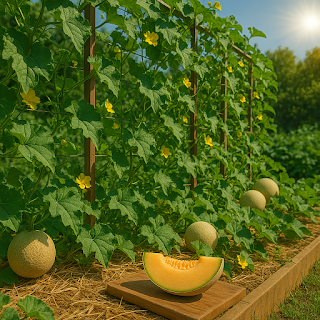How to Grow Cantaloupe from Seeds – A Sweet and Juicy Melon for Your Summer Garden
Cantaloupe (Cucumis melo) is a warm-season, vining melon known for its sweet, aromatic flesh and netted rind. With its juicy orange interior and refreshing flavor, it's a summertime favorite enjoyed fresh, in smoothies, or as a healthy snack. Growing Cantaloupe from seeds is both fun and rewarding, especially for gardeners looking to enjoy fresh melons straight from the vine.
At SeedFella.com, we provide premium-quality Cantaloupe seeds to help you grow delicious, high-yielding melons right in your backyard or balcony.
Why Grow Cantaloupe from Seeds
Choosing to grow Cantaloupe from seeds offers several garden benefits:
-
Produces sweet, nutrient-rich fruits with high water content
-
Rich in vitamin A, C, antioxidants, and dietary fiber
-
Thrives in warm climates and well-drained soils
-
Suitable for raised beds, trellised vertical gardens, or large containers
-
Offers a cost-effective and satisfying way to enjoy fresh, homegrown melons
When to Plant Cantaloupe Seeds
Proper timing is key to sweet melons:
-
Sow seeds after the danger of frost has passed and soil is consistently warm
-
Ideal planting time: late spring to early summer
-
Soil temperature should be at least 21°C (70°F) for successful germination
-
Germination takes 7–10 days under optimal warmth
Where to Plant Cantaloupe
Cantaloupe needs full sun and space to spread:
-
Select a location with 6–8 hours of direct sunlight
-
Soil should be loamy, rich in compost, and well-draining, pH 6.0–6.8
-
Ideal for open garden beds, trellised rows, or large containers
-
Avoid waterlogged spots—melons need dry feet and warm air
How to Plant Cantaloupe Seeds
-
Sow seeds ½ inch deep and space 18–24 inches apart
-
Water gently to keep soil evenly moist
-
Thin seedlings once true leaves appear, keeping the strongest plants
-
Add mulch to conserve moisture and control weeds
-
For container growing, use large pots (minimum 5 gallons) with support
How to Care for Cantaloupe Plants
Keep your Cantaloupe vines healthy for the best fruit:
-
Water deeply, 1–2 times a week—reduce as fruits near ripening
-
Apply balanced fertilizer or compost every 3–4 weeks
-
Hand-pollinate if needed to increase fruit set
-
Support fruits off the ground with mesh or slings to prevent rotting
-
Watch for pests like aphids, beetles, or powdery mildew—use neem spray if necessary
Companion Plants for Cantaloupe
Pair Cantaloupe with companion plants that improve growth and repel pests:
-
Good companions: basil, marigold, nasturtium, dill, and radish
-
Avoid planting near potatoes and cucumbers, which may compete for nutrients
-
Interplant with flowers to attract pollinators and enhance fruiting
Harvesting Cantaloupe
Harvest at peak ripeness for the best flavor:
-
Cantaloupes are ready when the skin turns beige and the fruit slips off the vine easily
-
The base of the melon develops a sweet aroma and slight softness
-
Use clean shears if the fruit doesn’t slip easily from the stem
-
Best harvested in the early morning for juiciest texture
Uses of Cantaloupe
Cantaloupe is a versatile and healthy fruit with many uses:
-
Eaten fresh in fruit salads, breakfast bowls, or smoothies
-
Juiced or blended for cool summer drinks
-
Paired with mint, lemon, or yogurt for refreshing treats
-
Can be grilled, chilled, or even pureed into soups
-
Ideal for hydrating and low-calorie snacking
Final Thoughts on Growing Cantaloupe
With a bit of warmth, space, and care, Cantaloupe is one of the most rewarding fruits to grow at home. Its sweetness, versatility, and vibrant appearance make it a garden favorite that’s both delicious and easy to cultivate.
Start growing your own by ordering Cantaloupe seeds now from SeedFella.com and enjoy garden-fresh melons all summer long.






Comments
Post a Comment